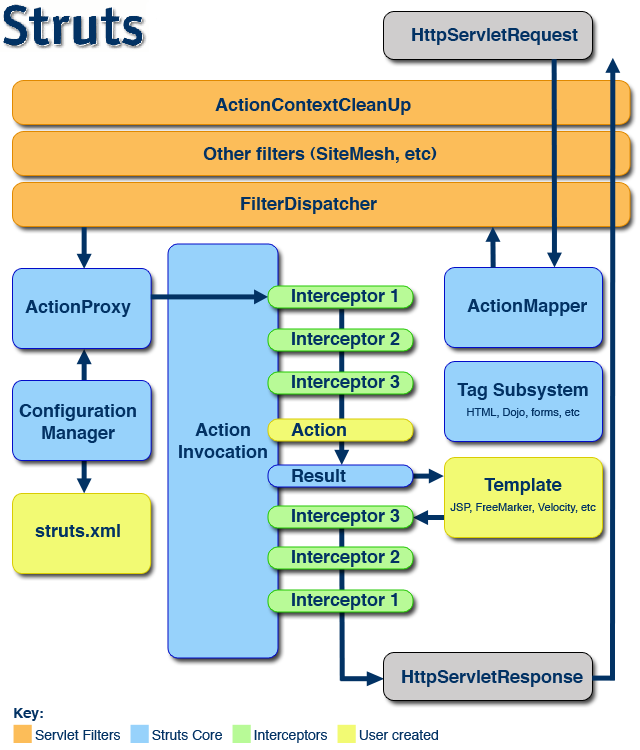在上个博客中已经写清楚了,初始化是在init中,当拦截一个请求会执行doFilter方法

1、它将请求传递给一个标准的的过滤链包括 (ActionContextCleanUp)过滤器
2、然后经过Other filters(SiteMesh ,etc),
3、接下来需要调用FilterDispatcher核心控制器,
4、然后它调用ActionMapper确定请求那个Action,
ActionMapper返回一个收集Action详细信息的ActionMaping对象。
5、接下来FilterDispatcher将控制权委派给ActionProxy,
6、ActionProxy调用配置管理器(ConfigurationManager) 从配置文件中读取配置信息(struts.xml),
7、然后创建ActionInvocation对象
8、ActionInvocation在调用Action之前会依次的调用所用配置拦截器(Interceptor N)
9、一旦执行结果返回结果字符串,ActionInvocation负责查找结果字符串对应的(Result)
10、然后执行这个Result ,Result会调用一些模版(JSP)来呈现页面
11、之后拦截器(Interceptor N)会在被执行(顺序和Action执行之前相反)最后响应(HttpServletResponse)被返回在web.xml中配置的那些过滤器和(核心控制器)(FilterDispatcher)。
public void doFilter(ServletRequest req, ServletResponse res, FilterChain chain) throws IOException, ServletException {
HttpServletRequest request = (HttpServletRequest) req;
HttpServletResponse response = (HttpServletResponse) res;
try {
prepare.setEncodingAndLocale(request, response);
prepare.createActionContext(request, response);
prepare.assignDispatcherToThread();
if (excludedPatterns != null && prepare.isUrlExcluded(request, excludedPatterns)) {
chain.doFilter(request, response);
} else {
request = prepare.wrapRequest(request);
ActionMapping mapping = prepare.findActionMapping(request, response, true);
if (mapping == null) {
boolean handled = execute.executeStaticResourceRequest(request, response);
if (!handled) {
chain.doFilter(request, response);
}
} else {
execute.executeAction(request, response, mapping);
}
}
} finally {
prepare.cleanupRequest(request);
}
}如果是正常的Action请求,prepare.findActionMapping(request, response, true);这句话便会寻找在struts.xml中的action。然后执行 execute.executeAction(request, response, mapping);
源码
public void executeAction(HttpServletRequest request, HttpServletResponse response, ActionMapping mapping) throws ServletException {
dispatcher.serviceAction(request, response, servletContext, mapping);
}其中serviceAction会执行调度器dispatcher的serviceAction
public void serviceAction(HttpServletRequest request, HttpServletResponse response, ServletContext context,
ActionMapping mapping) throws ServletException {
Map<String, Object> extraContext = createContextMap(request, response, mapping, context);
// If there was a previous value stack, then create a new copy and pass it in to be used by the new Action
ValueStack stack = (ValueStack) request.getAttribute(ServletActionContext.STRUTS_VALUESTACK_KEY);
boolean nullStack = stack == null;
if (nullStack) {
ActionContext ctx = ActionContext.getContext();
if (ctx != null) {
stack = ctx.getValueStack();
}
}
if (stack != null) {
extraContext.put(ActionContext.VALUE_STACK, valueStackFactory.createValueStack(stack));
}
String timerKey = "Handling request from Dispatcher";
try {
UtilTimerStack.push(timerKey);
//获取请求action的具体信息
String namespace = mapping.getNamespace();
String name = mapping.getName();
String method = mapping.getMethod();
Configuration config = configurationManager.getConfiguration();
//创建代理对象
ActionProxy proxy = config.getContainer().getInstance(ActionProxyFactory.class).createActionProxy(
namespace, name, method, extraContext, true, false);
request.setAttribute(ServletActionContext.STRUTS_VALUESTACK_KEY, proxy.getInvocation().getStack());
// if the ActionMapping says to go straight to a result, do it!
if (mapping.getResult() != null) {
Result result = mapping.getResult();
result.execute(proxy.getInvocation());
} else {
proxy.execute();
}
// If there was a previous value stack then set it back onto the request
if (!nullStack) {
request.setAttribute(ServletActionContext.STRUTS_VALUESTACK_KEY, stack);
}
} catch (ConfigurationException e) {
// WW-2874 Only log error if in devMode
if (devMode) {
String reqStr = request.getRequestURI();
if (request.getQueryString() != null) {
reqStr = reqStr + "?" + request.getQueryString();
}
LOG.error("Could not find action or result\n" + reqStr, e);
} else {
if (LOG.isWarnEnabled()) {
LOG.warn("Could not find action or result", e);
}
}
sendError(request, response, context, HttpServletResponse.SC_NOT_FOUND, e);
} catch (Exception e) {
if (handleException || devMode) {
sendError(request, response, context, HttpServletResponse.SC_INTERNAL_SERVER_ERROR, e);
} else {
throw new ServletException(e);
}
} finally {
UtilTimerStack.pop(timerKey);
}
}关于值栈的部分我就不分析了,这个调度器会根据请求的action用动态代理生成一个代理类 ActionProxy proxy
动态代理必须有代理类的类加载器、接口、和继承invocationHandle的类,这次是DefaultActionInvocation,
当执行proxy.execute();ActionProxy是一个接口,会调用默认实现类StrutsActionProxy里面的execute方法。
public String execute() throws Exception {
ActionContext previous = ActionContext.getContext();
ActionContext.setContext(invocation.getInvocationContext());
try {
return invocation.invoke();
} finally {
if (cleanupContext)
ActionContext.setContext(previous);
}
}当执行invocation.invoke();就会执行DefaultActionInvocation里面的方法。
public String invoke() throws Exception {
String profileKey = "invoke: ";
try {
UtilTimerStack.push(profileKey);
if (executed) {
throw new IllegalStateException("Action has already executed");
}
//迭代拦截器,并以此执行
if (interceptors.hasNext()) {
final InterceptorMapping interceptor = interceptors.next();
String interceptorMsg = "interceptor: " + interceptor.getName();
UtilTimerStack.push(interceptorMsg);
try {
resultCode = interceptor.getInterceptor().intercept(DefaultActionInvocation.this);
}
finally {
UtilTimerStack.pop(interceptorMsg);
}
} else {
resultCode = invokeActionOnly();
}
// this is needed because the result will be executed, then control will return to the Interceptor, which will
// return above and flow through again
if (!executed) {
if (preResultListeners != null) {
for (Object preResultListener : preResultListeners) {
PreResultListener listener = (PreResultListener) preResultListener;
String _profileKey = "preResultListener: ";
try {
UtilTimerStack.push(_profileKey);
listener.beforeResult(this, resultCode);
}
finally {
UtilTimerStack.pop(_profileKey);
}
}
}
// now execute the result, if we're supposed to
if (proxy.getExecuteResult()) {
executeResult();
}
executed = true;
}
return resultCode;
}
finally {
UtilTimerStack.pop(profileKey);
}
}在执行具体方法前会迭代拦截器栈,然后逐个执行各个拦截器(这部分不太详细,等有时间在研究)
执行完拦截器, 然后在执行监听器,最后返回result,到这里 整个流程基本已经结束了






















 852
852

 被折叠的 条评论
为什么被折叠?
被折叠的 条评论
为什么被折叠?








